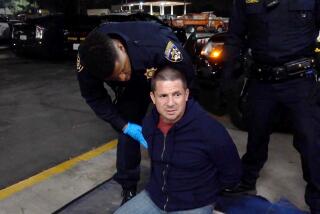Man Who Shot CHP Officer Had Used Cocaine
- Share via
Terry James Parker, the ex-convict who shot a CHP officer before being killed by police, had used cocaine before the early morning confrontation, according to a toxicology report.
“He was apparently under the influence of cocaine at the time,” said Scott Carrier, spokesman for the Los Angeles County coroner. “Any measurable amount of cocaine is significant. This is significant.”
Parker, who had a history of police confrontations as well as alcohol and drug abuse, shot CHP Officer Rafael “Ralph” Casillas in the abdomen, thigh and wrist on July 24. Casillas remains in critical condition in the intensive care unit at Los Angeles County/USC Medical Center.
Casillas’ condition, however, improved slightly Friday with doctors reporting that his lungs showed signs of clearing and that his white blood count had dropped.
“They are minor improvements but this is definitely a step in the right direction,” said CHP Officer Larry Albrecht, who works in the Newhall station where Casillas is assigned. “We’re just praying that this trend continues.”
Parker failed to pull over for Casillas and his partner, who followed Parker to his Granada Hills home. Authorities said Parker ran inside the house and shot Casillas as he approached the doorstep. Parker then fled into the neighborhood, shot himself in the mouth and then was killed by pursuing police.
CHP Commissioner Dwight “Spike” Helmick said Friday’s toxicology report underscores the dangers law enforcement officers face when stopping motorists.
“We are running into larger numbers of people on speed, cocaine or a mixture with alcohol out there,” Helmick said. “It is out there--there’s no question about it.”
Helmick said the officers knew Parker had used either drugs or alcohol because he was driving erratically. When the officers initially tried to pull over Parker for speeding, he slowed but continued on to his Harvest Street home.
As a result of the CHP’s increased confrontations with drugged individuals, Helmick said the agency is providing officers with additional training to more quickly identify drunk or drugged drivers.
“We have people getting into these confrontations increasingly,” Helmick said.
The 25-year-old Parker, who was released from prison just a month before the shooting, had a lengthy criminal past. He had a strikingly similar confrontation with police two years ago when officers shot and wounded Parker. His driver’s license was suspended four times and then revoked because of drunk-driving convictions and he also previously was a user of crack cocaine.
While in prison, Parker was given two mood-altering drugs but stopped taking the medication when he was released, authorities said.
He also apparently did not participate in any drug or alcohol abuse programs while in prison, where he served a 20-month term for evading police, firing a weapon and possessing cocaine.
At the time of his death, Parker’s father said his son was paranoid and believed he would again confront police. After he was shot in 1994, Parker said he wished the police had killed him.
More to Read
Sign up for Essential California
The most important California stories and recommendations in your inbox every morning.
You may occasionally receive promotional content from the Los Angeles Times.










